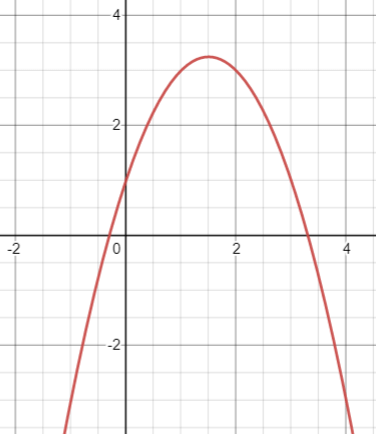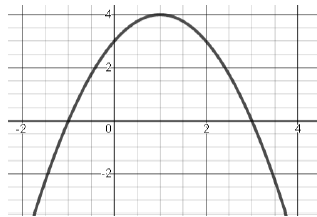PROBLEMS INVOLVING QUADRATIC FUNCTIONS
The equation which is in the form
f(x) = ax2 + bx + c
is known as quadratic equation.
The graphical form of quadratic function is parabola. Based on the signs of a, we can say the parabola opens upward or downward.
- If sign of a is +, then the parabola opens upward.
- If sign of a is -, then the parabola opens downward.
Equation of parabola can be converted into three different forms.
- Standard form
- Vertex form
- Factored form.
How to convert into standard form ?
Example :
Write y = 2(x+1)2 + 4 in standard form.
Solution :
y = 2(x+1)2 + 4
Using the formula (a + b)2, we get
y = 2(x2 + 2x + 1) + 4
y = 2x2 + 4x + 2 + 4
y = 2x2 + 4x + 6
How to convert into vertex form ?
Example :
Convert y = x2 + 4x - 3 into vertex form.
Solution :
y = x2 + 4x - 3
y = x2 + 2 ⋅ x ⋅ 2 + 22 - 22 - 3
y = (x+2)2 - 4 - 3
y = (x+2)2 - 7
By converting the equation with vertex form, we can find vertex (h, k)
How to convert into factored form ?
Example :
Convert y = x2 - 4x + 3 into factored form.
Solution :
y = x2 - 4x + 3
y = x2 - 1x - 3x + 3
y = x(x - 1) -3(x - 1)
y = (x-1)(x - 3)
By applying x = 0, we will get y-intercept and by applying y = 0, we will get x-intercept.
Problem 1 :
Which of the following gives the solution set for the polynomial equation below?
x2−11𝑥+19 = −5
A. {-3, -8} B. {3, 8} C. {-3, 8} D. {3, -8}
Solution :
x2−11𝑥+19 = −5
Add 5 on both sides.
x2−11𝑥+19+5 = 0
x2−11𝑥+24 = 0
(x - 3) (x - 8) = 0
Equating each factors to zero, we get
x = 3 and x = 8
So, the solution set is {-8, 3}
Problem 2 :
Which of the following could be the equation for the polynomial function below?

A. y = −x2+3x+1 B. y = x2−0.25x+3.25
C. y = x2−x+3 D. y=−x2+0.25x−3.25
Solution :
From the graph, the parabola opens down. So, we can clearly reject options B and C.
Option (A) :
𝑦 = −x2+3x+1
Converting into vertex form, we get
h = 3/2 and k = 13/4
From the graph, the vertex in between 2 and 4. So, option A is correct.
Problem 3 :
Which of the following is an equation for the function below and gives the coordinates of the vertex as constants or coefficients?

A. y = −(x−3)(x+1) B. y = −x2+2x+3
C. y = (x+1)2+4 D. y = −(x−1)2+4
Solution :
y = −(x−3)(x+1)
Equating each factor to zero, we get
x = 3 and x = -1
By observing the graph given above, it opens downward and x-intercepts are 3 and -1.
Finding vertex :
y = −(x−3)(x+1)
y = −(x2-3x+1x−3)
y = −(x2-2x−3)
y = −(x2 - 2⋅x⋅1 + 12 -12 − 3)
y = −[(x-1)2 - 4]
y = −(x-1)2 + 4
Vertex is (1, 4).
So, option A is correct.
Problem 4 :
How many solutions are there to the following system of equations?
y = −(1/2)x2+7 and 𝑦 = −2x2+5
A. 0 B. 1 C. 2 D. 3
Solution :
y = −(1/2)x2+7 ------(1) y = −2x2+5 ------(2)
To find the points of intersection, we can solve (1) and (2).
(1) = (2)
−(1/2)x2+7 = −2x2+5
-x2 + 14 = -4x2 + 10
3x2 = -10 - 14
3x2 = -24
x2 = -8
x = √-8
It is not real number, so it will not have solution. So, zero solution is the answer.
Recent Articles
-
Finding Range of Values Inequality Problems
May 21, 24 08:51 PM
Finding Range of Values Inequality Problems -
Solving Two Step Inequality Word Problems
May 21, 24 08:51 AM
Solving Two Step Inequality Word Problems -
Exponential Function Context and Data Modeling
May 20, 24 10:45 PM
Exponential Function Context and Data Modeling